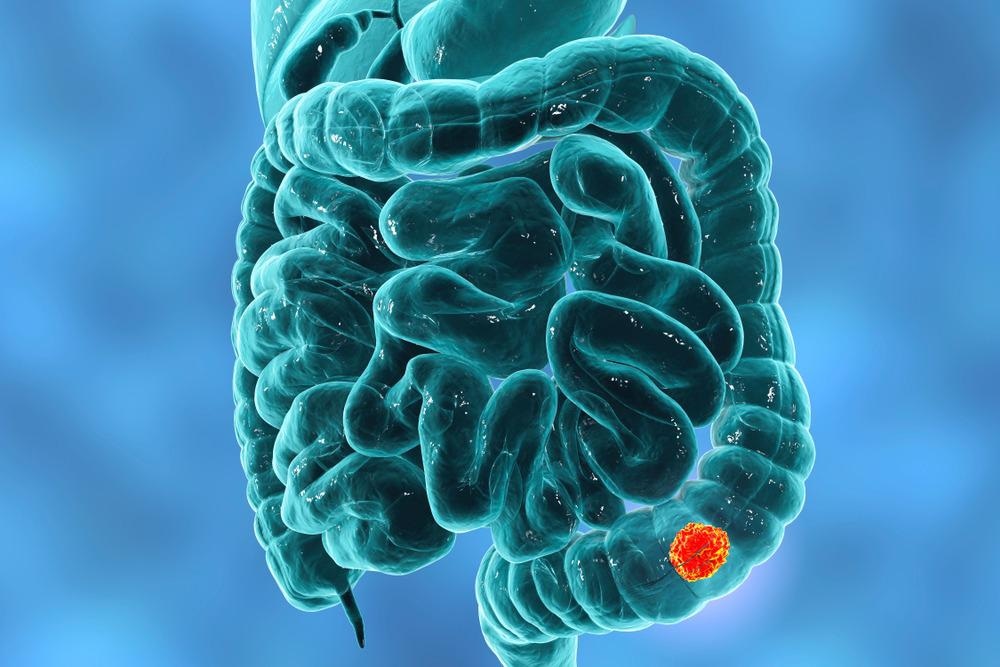A recent surge in using biomolecules as carrier systems led to the development of biomolecule-based nanoparticles (NPs) for cancer treatment. In an article recently published in the journal Materials Today Communications, authors developed encorafenib (ECF) encapsulated hyaluronic acid (HA)-decorated polycaprolactone (PCL) and polyhydroxybutyrate (PHB) polymeric NPs to treat colorectal cancer. They hypothesized that the synthesized NPs lowered reactive oxygen species (ROS) by cellular internalization and subsequent apoptotic arrest.

Study: Development and characterization of Hyaluronic acid surface scaffolds Encorafenib loaded polymeric Nanoparticles for colorectal cancer targeting. Image Credit: Kateryna Kon/Shutterstock.com
Polymers in Drug Delivery
Site-specific drug targeting enhances the bioavailability of a drug at a target receptor site, and conjugating drug molecules with polymer macromolecules could serve the purpose. To this end, limited antecedents reported the combination of HA with PCL and PHB, suggesting that fabricating such polymer-based therapeutic agents can protect the drug molecules from any enzymatic or chemical degradation, thus enhancing their physicochemical stability. Nanoformulation that entails such polymer-based therapeutic agents could be potential carrier systems in cancer treatment to improve target specificity in drug release and consequent cellular absorption.
PCL’s outstanding solubility and biocompatibility are suitable properties for drug encapsulation. Due to its degradation by microbial esterase and lipase, PCL could be used for colon-specific drug encapsulation. Moreover, surface modification of NPs with ligands and PCL can improve the drug delivery to cells. The hydrophobicity of PCL is advantageous for transporting hydrophobic chemotherapeutics like biopharmaceutical classification system (BCS) class II and IV drugs. Thus, encapsulating a BSC class II drug, ECF could improve its delivery and bioavailability at the target site. PHB is a biological polyester found in eukaryotic and bacterial cells. Combining PHB with 5-fluorouracil and cellulose acetate phthalate can facilitate colorectal cancer treatment.
HA, a naturally occurring mucopolysaccharide, possesses properties like non-immunogenicity, biocompatibility, chemical versatility, biodegradability, and nontoxicity. Additionally, since HA is a non-sulfated glycosaminoglycan, that has a strong affinity for CD44-overexpressing colon cancer cells. N-acetyl-d-glucosamine and d-glucuronic acid are the two constituents of HA that interact with overexpressed CDD4 cancer cells.
ECF Loaded Polymeric NPs
In the present study, researchers formulated ECF-PHB-NPs, ECF-PCL-NPs, HA-ECF-PCL-NPs, and HA-ECF-PHB-NPs to minimize drug demand and improve their bioavailability. The as-prepared polymeric NPs were characterized for their morphology, zeta potential, in vitro drug release profile, biocompatibility, pharmacokinetic profiling, and histopathology. The objective behind preparing the aforementioned polymeric NPs was to improve their cellular uptake by downregulating the CD44-overexpressing colorectal cancer cells. Additionally, HCT116 colorectal cancer cell lines were used for in vitro anticancer and genotoxicity studies.
Research Findings
Scanning electron microscope (SEM) images showed that ECF-loaded polymeric NPs had a particle size of less than 200 nanometers and polarity dispersity index (PDI) of less than 0.3. The zeta potential and particle size of HA-ECF-PHB-NPs confirmed that conjugating ECF-loaded polymeric NPs with HA increased the particle size of NPs due to the mucopolysaccharide nature of HA. Similarly, PHB-conjugated ECF-loaded polymeric NPs showed a particle size (162.32±4.52 nanometers) higher than the PCL conjugated counterparts (157.56±6.78 nanometers) due to the physical flexibility of PCL.
Owing to the presence of N-acetyl-D-glucosamine and D-glucuronic acid copolymer in HA, the researchers observed the high anionic nature of HA-ECF-polymeric NPs, that is -32.67±3.34 millivolts for HA-ECF-PCL-NPs and 33.37±3.78 millivolts for HA-ECF-PHB-NPs, respectively. Such copolymers increase the molecular weight and negative zeta potential of NPs. Furthermore, due to the presence of polyester diols and PVA of free radicals on the surface of the NPs, the PCL-ECF polymeric NPs showed a negative zeta potential of -15.78±4.01 millivolts.
The researchers observed that the nature of the polymer had a significant impact on drug entrapment efficiency and drug loading. The polymer’s molecular mass significantly impacted yield, drug loading capacity, and entrapment efficiency. The higher molecular weight of HA (3x106 gram per mole) provided rigidity for the NPs, enabling high drug entrapment and drug loading efficiency in HA-ECF-PCL-NPs and HA-ECF-PHB-NPs. Owing to the electrostatic interaction between polymers and ECF, the latter showed maximum adsorption on the surface of the polymers.
Fourier transform infrared (FTIR) spectra of ECF showed characteristic peaks at 3399.84 and 1629.25 centimeter inverse corroborating the presence of amides (RCONH2) and corresponding amine (N-H) bending. The FTIR spectra of PCL showed dimer hydroxyl (-OH) peak at 3334.37-centimeter inverse and olefinic (C=C) stretch at 1669.92 centimeter inverse. PBL showed a characteristic peak at 1752.74-centimeter inverse, indicating the presence of unconjugated ester.
Conclusion
In conclusion, the team fabricated HA-coated ECF polymeric NPs (HA-ECF-PHB-NPs, and HA-ECF-PCL-NPs) to treat colorectal cancer. Due to the favorable properties like appropriate particle size, entrapment efficiency, sustained ECF release, biocompatibility, and excellent pharmacokinetic profile, HA-ECF-PHB-NPs were determined as optimum formulation. Performing a hemolysis test and evaluating the erythrocyte’s membrane integrity confirmed the biocompatibility of prepared NPs. The higher rough surface of the NPs observed by atomic force microscopy (AFM) analysis suggested the possibility of vector conjugation.
Reference
Bhattacharya, S., Singh, D., Aich, J., Ajazuddin and Shete, M (2022). Development and Characterization of Hyaluronic Acid Surface Scaffolds Encorafenib Loaded Polymeric Nanoparticles for Colorectal Cancer Targeting. Materials Today Communications. https://www.sciencedirect.com/science/article/pii/S2352492822006171
Disclaimer: The views expressed here are those of the author expressed in their private capacity and do not necessarily represent the views of AZoM.com Limited T/A AZoNetwork the owner and operator of this website. This disclaimer forms part of the Terms and conditions of use of this website.